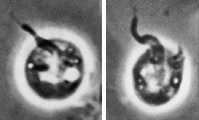Apusomonas
Rostromonas
David J. PattersonIntroduction
The genus Apusomonas includes flattened gliding flagellates in which the anterior flagellum emerges from a projecting mastigophore. There are two flagella, and both insert near the projecting end of the mastigophore. The second flagellum runs backwards to lie under the cell - and usually it cannot be seen. The mastigophore beats slowly as the cell moves.
Species in this genus eat bacteria, with the food being ingested taken ventrally. Temporary cysts may be formed, and the genus is cryptobiotic - i.e. the organism can dry out. The genus is common in soils (world-wide) and has also been reported from fresh-waters.
There are two species. The type species is A. proboscidea Aléxéieff 1924.
This genus has a clear identity (sensu Patterson 1999). It was not reported for 50 years after the publication of the original description by Aléxéieff. In 1974 Vickerman and co-workers published a detailed light- and scanning-electron microscopy which has provided the genus with its current identity. The delay between the original paper and that of Vickerman and colleagues may explain why the same taxon was studied independently by Karpov and Zhukov (1986) under the name Rostromonas.
Characteristics
Apusomonas is distinguished from Amastigomonas principally because it has a mastigophore, an anterior prolongation of the cell into which the flagellum inserts. Species are separated on the shape of the cell.
References
Cavalier-Smith, T. and Chao, E. E. 1995. The opalozoan Apusomonas is related to the common ancestor of animals, fungi and choanoflagellates. Proceedings of the Royal Society of London B 261:1-6.
Ekelund, F. and Patterson, D. J. 1997. Some flagellates from a cultivated garden soil in Australia. Archiv für Protistenkunde 148:461-478.
Karpov, S. A. & Mylnikov, A. P. 1989. Biology and ultrastructure of colourless flagellates Apusomonadida ord. n. Zoologischkei Zhurnal 58:5-17. (in Russian)
Karpov, S. A. & Zhukov, B. F. 1980. Rostromonas applanata gen. et sp. n. (Zoomastigophorea, Protozoa) a new representative of freshwater fauna. Zoologischkei Zhurnal 59:1733-1735. (in Russian)
Karpov, S. A. & Zhukov, B. F. 1986. Ultrastructure and taxonomic position of Apusomonas proboscidea Aléxéieff. Archiv für Protistenkunde 131:13-26.
Patterson, D. J. 1999. The diversity of eukaryotes. American Naturalist 154 (suppl.):S96-S124.
Vickerman, K., Darbyshire, J.F. and Ogden, C.G. 1974. Apusomonas proboscidea Aléxéieff 1924, An Unusual Phagotrophic Flagellate from Soil. Archiv für Protistenkunde 116:254-269.
About This Page
David J. Patterson

Marine Biological Laboratory, Woods Hole, Massachusetts, USA
Correspondence regarding this page should be directed to David J. Patterson at
Page copyright © 2000 David J. Patterson
 Page: Tree of Life
Apusomonas . Rostromonas .
Authored by
David J. Patterson.
The TEXT of this page is licensed under the
Creative Commons Attribution License - Version 3.0. Note that images and other media
featured on this page are each governed by their own license, and they may or may not be available
for reuse. Click on an image or a media link to access the media data window, which provides the
relevant licensing information. For the general terms and conditions of ToL material reuse and
redistribution, please see the Tree of Life Copyright
Policies.
Page: Tree of Life
Apusomonas . Rostromonas .
Authored by
David J. Patterson.
The TEXT of this page is licensed under the
Creative Commons Attribution License - Version 3.0. Note that images and other media
featured on this page are each governed by their own license, and they may or may not be available
for reuse. Click on an image or a media link to access the media data window, which provides the
relevant licensing information. For the general terms and conditions of ToL material reuse and
redistribution, please see the Tree of Life Copyright
Policies.
- First online 18 September 2000
Citing this page:
Patterson, David J. 2000. Apusomonas . Rostromonas . Version 18 September 2000. http://tolweb.org/Apusomonas/20484/2000.09.18 in The Tree of Life Web Project, http://tolweb.org/










 Go to quick links
Go to quick search
Go to navigation for this section of the ToL site
Go to detailed links for the ToL site
Go to quick links
Go to quick search
Go to navigation for this section of the ToL site
Go to detailed links for the ToL site